Do you really need to do a soil test?
‘So how many people in this room have done a soil test?’
This question was asked by garden designer Adam Frost at a recent talk at the Painters Forstal Gardening Club.
There were over 80 keen gardeners in the room. About half a dozen raised their hands. Embarrassingly I wasn’t one of them – even though a friend of mine had lent me a soil tester and was also in the audience. Rumbled!
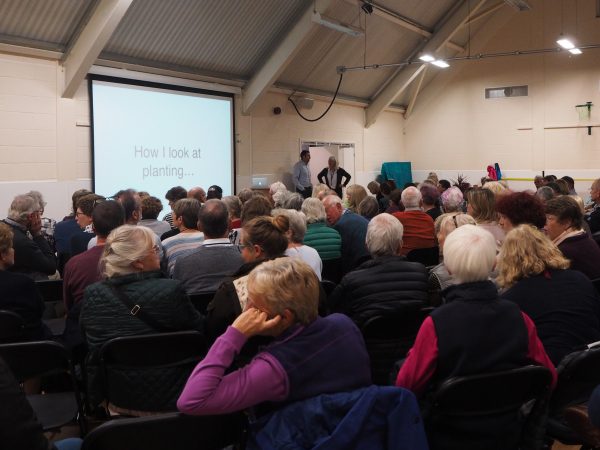
Only about half a dozen keen gardeners in this room had done a soil test.
Many gardening friends say they don’t feel they need to do a soil test. ‘I know what I can grow in my garden.’
However, I’ve had very erratic results in the veg patch over several years. Several people have suggested that it’s my soil. Everyone who grows plants has failures – but if plants are consistently failing to thrive in a particular spot, it’s clear that a soil test is essential.
And if you move to a new house, you can circumvent the many years of discovering that acers (for example) don’t do well in your soil. If I’d done a soil test when we moved in, I wouldn’t have planted either of the two acers that struggled for a few years, then died. I would have planted another type of tree, and it would now be a decent size.
And no, seeing your neighbour’s lovely acer isn’t always a help. There are often pockets of different soil types, even in middle-sized town gardens.
It’s time to conquer my fear of anything that reminds me of school science classes and do a soil test.
Which soil test to buy?
I looked online for reviews, and also on Amazon to see which soil tests were rated most highly. The Testwest Soil Test kit and the Moon City 3-in-1 Soil Tester seemed to be top favourites.
I bought one of each, intending to compare them. (Links to Amazon are affiliate links, which mean I may get a small fee if you buy through them, but it won’t affect the price you pay.)
In fact, they are completely different. The TestWest Soil Kit tests pH, Nitrogen, Potassium & Phosphorus. The Moon City 3-in-1 tests pH, moisture and light. So actually both very useful.
Start with the really easy part
The Moon City 3-in-1 is outrageously easy. I cannot imagine why I worried about it. All you do is jam it in the soil.
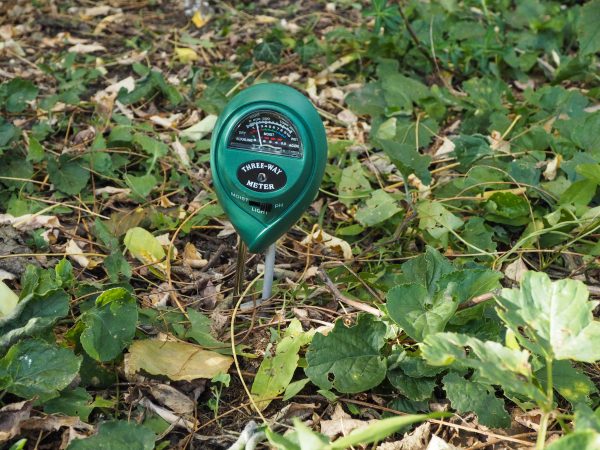
The Moon City Three Way Soil Tester – it really couldn’t be easier. It measures how much light and moisture a particular spot gets, and the pH, but not the level of nutrients. Excuse the weeds…
It has a three-way switch, which you change accordingly to whether you are measuring the moisture in the soil, the light available in that spot or the pH. The dial responds quickly. Apart from the awkwardness of having to lie flat on the ground to read the results, you have an instant easy answer.
Bearing in mind that Adam Frost tested dozens of spots in his garden, I did the same. The moisture readings were what I expected, and in most of the garden, the pH read as neutral (pH 7).
But in one spot – one of my veg beds – it read as very acid, with a pH below 4. I looked up what grows well in such soil. Nasturtiums, apparently.
And that part of that veg bed is full of self-seeded nasturtiums! They don’t go anywhere else in the garden, but I’d never thought to wonder why.
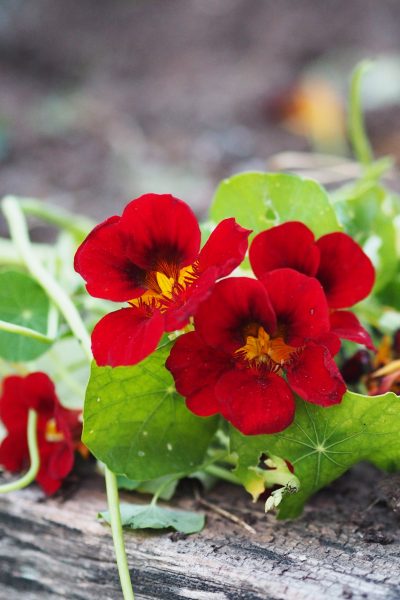
These nasturtiums self-seed vigorously, but only in one of the borders – the one that is exceptionally low for nutrients and pH level.
The next soil test
I needed to delve deeper, so suppressed unhappy memories of the school science lab and opened the Testwest Soil Test Kit. I’ve video-d this. If you are someone who hates reading instructions, you may find watching less tedious.If you just want the soil test ‘how to’, fast forward to 1 minute, 16 seconds.
The Testwest Soil Test kit has four vials, each with a different chemical, for measuring the pH, Nitrogen, Potassium & Phosphorus. You don’t measure Nitrogen until the spring, so I didn’t do that.
There are also four little sample bottles, each with a coloured cap, a small amount of powder in a coloured marked container and a tiny coloured spoon. The colours are the key!
You dig out 50 grams of soil from various spots in the garden, and add 200ml of water. I took the kitchen scales outside, and a measuring jug.
Put the soil and water in a jam jar, shake it for 30 seconds or so, then leave until it separates again.
Repeat for several parts of the garden. I can only think that Adam Frost must have a magnificent collection of jam jars if he did dozens of soil tests in his garden.
Keep everything labelled and written down
I used Post-it Notes to make sure that I knew which jar connected with which part of the garden. And I wrote the results of each test down as soon as I had them, on the relevant Post-It note.
That may sound simplistic, but if you’re juggling three different tests for six different soil test samples, it can easily get confusing.
The linked colours on the test tubes, vials, powder containers and spoons mean that the test is not difficult, although the final stages of the soil test do get a bit fiddly.
Once your soil and water has separated out again, you use the pipette (provided) to add 3mls of slightly cloudy water to a test tube. Then add 0.5ml of the liquid in the vial that matches that test tube and a ‘heaped spoonful’ of the powder (the matching coloured spoon is tiny). Shake thoroughly and leave for around five minutes to settle.
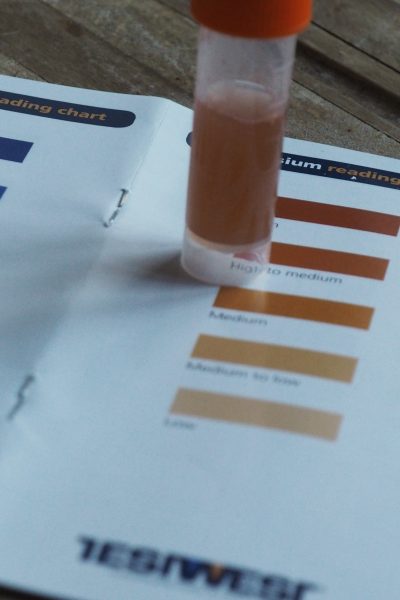
The Testwest Soil Tester Kit measures pH, Nitrogen, Phosporus and Potassium in your soil.
Then you match it against a palette of colours in the booklet provided.
By this time, I was not only impressed with Adam Frost’s (theoretical) collection of jam jars, but also his patience.
Interesting results
My soil test results indicated that most of my borders have ‘medium’ amounts of nutrients. And the Testwest kit pH test results echoed those of the Moon City 3-in-1. I have neutral soil at a pH of 7. Lucky me.
However, the veg bed that had shown up as acid in the Moon City test also showed as very deficient in both Phosphorus and Potassium in the Testwest soil test results. I’m not really certain why, as I thought I’d given all the beds a good mulch of homemade compost every autumn. But it’s possible that I missed that bed out.
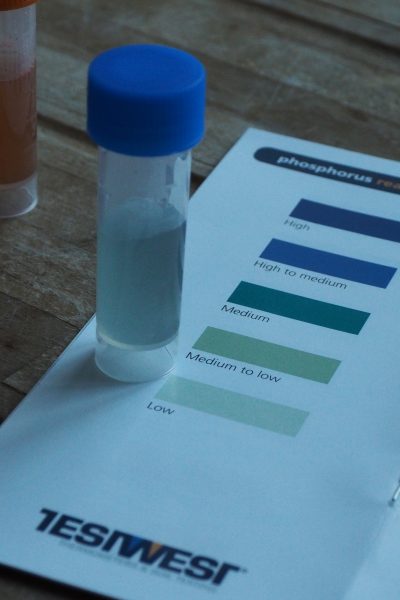
The veg bed is very low in phosphorus, according to the chart.
It would certainly explain why the veg have not grown well there – but the nasturtiums have flourished – this year.
So what now?
The whole garden needs a proper mulch this autumn. There’s nothing to worry about if you have a ‘medium’ level of nutrients, but it’s not exactly bursting with health, is it? I don’t propose to add specific fertilisers, but I’ll re-test next year and see whether I have to do anything more.
I shall be following Charles Dowding’s No Dig advice – although I can find no trace of reference to soil tests in his excellent book Organic Gardening, the Natural No-Dig Way. (There is a pithy remark on ‘soil health has more to do with biology than chemistry.’ So we’ll take that as a ‘no soil test’ then, shall we?)
But I shall let the compost sit on the top of the soil, allowing the worms and micro-organisms to do the hard work of digging for me.
I also see that the addition of seaweed may be helpful, and we live near the sea. You are generally allowed to take small amounts of seaweed from the beach in the UK, but check your local council regulations.
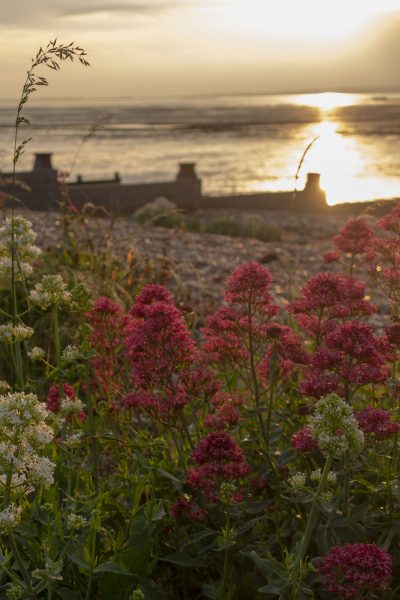
Nearby Whitstable beach. You don’t have an automatic right to take seaweed off a beach so ask your local Council – or other beach owners such as the National Trust.
Meanwhile perhaps I should try out that recipe for Nasturtium Pesto I spotted somewhere on the Internet the other day….
Let me know if you have views on soil tests and whether you’ve found them useful. And if you have other brand recommendations, let us know in the comments below. Thank you!
Pin for reference
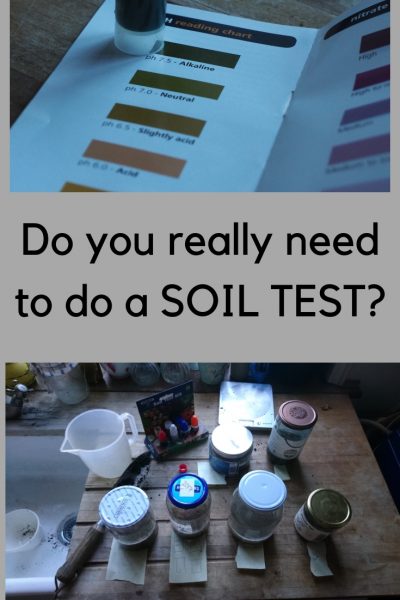
























I’m intrigued to know what the results will say next year. You’ve given me more reason to test than not test on our new to us but used for food growth since 1800’s veggie patch. Its been neglected for about 10 years but we’ve dug up a few potatoes whilst clearing the area back :)
Thanks for your article.
How interesting that potatoes last so long, happily just reproducing every year!
I asked Charles Dowding point blank if he ever does soil testing. His response was “No testing. Plants do it and no dig relies more on biology.”
Yes, he said that to me, too.
Great article. I too have experimented with a few of these with mixed results. Apologies for the overtly commercial pitch but considering Britain’s industrial history, in some cases it may make sense to test soil for contamination and pollution. It isn’t easy to find a service that will test and analyse soil for this, which is why we’ve launched Safe Soil UK. Thank you.
thank you for making that point. I have known at least one garden (attached to a recently built house) that had an issue with soil contamination so I’m happy to include your link for anyone who is interested in getting their soil tested for potential contamination: https://www.safesoil.co.uk/
Highly acidic soils have very low fertility, almost an absence of activity.
We created this bed and brought soil from elsewhere in the garden, so it may be that we can correct it by adding more topsoil and hummus. But I shall test again, thank you for commenting